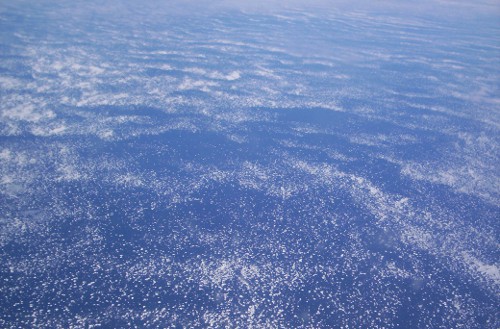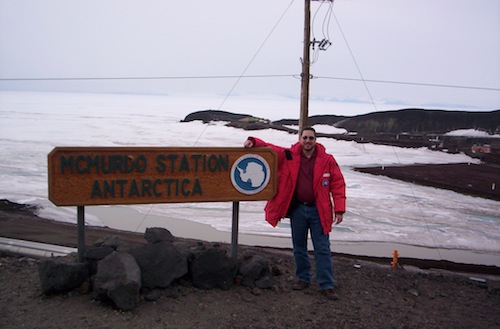I got up today at 5:15 am with great excitement, knowing that in a few hours I would be boarding my flight for Antarctica. Here is a summary of this exciting day.

The day before we had left USAP(abbreviation) United States Antarctic Program at around 4:00 pm, and later on went for dinner in Christchurch. I went to bed at about 10:00 pm and woke up feeling well rested and refreshed. I picked up my luggage—which I had already packed the night before—and checked out of Pavillions Hotel. A bus came at exactly 6:00 am to pick us up, as we had been instructed to report to the USAP(abbreviation) United States Antarctic Program offices at 6:30 am. There were about eight people in the bus, including three IceCubers: James, Hans and I.

A few minutes later we arrived at the facility. We picked up the extreme cold weather (ECW(abbreviation) Extreme Cold Weather clothing) gear that was handed down to us on Monday and put it in. This is standard procedure when flying to, from or throughout Antarctica. No one is allowed to board or unboard the airplane unless wearing the red USAP(abbreviation) United States Antarctic Program parka, boots, plus four other key items. There were multiple posters on the walls detailing all procedures and explaining everything to us.

At 7:20 am we went in for a briefing explaining all aspects of travel to Antarctica that USAP(abbreviation) United States Antarctic Program participants and grantees need to know. Travel logistics were again explained to us, as well as security and safety precautions. There are also strict ecological guidelines to abide to while visiting Antarctica. At 8:00 pm we took yet another bus that took us to the airfield and started boarding. Engines were started and we took to the air at exactly 9:25 am. Flight time to McMurdo Station would be exactly eight hours, just as we had been told.

This flight was different, as we traveled in a ski-equipped cargo airplane. Thirty-six people were in the plane: 32 passengers and 4 crew. There were among us a number of participants of the Antarctica New Zealand program, who were headed for Scott Base, which is located in Ross island just steps away from McMurdo Station. Once inside the airplane we were allowed to shed part of our gear, on condition that it remained in hand for use immediately after landing.

Cargo aircraft such as the one we flew in do not really have passenger cabin windows, like regular commercial airplanes. But there are usually two or three small windows on each side, and I was fortunate to sit exactly by one of those. I watched out and started seeing drift ice in the ocean like halfway during the trip, which would translate into a latitude of approximately 60 degrees south. Later on—from about three quarters of the way, onwards, latitude 70 and beyond—I saw large packs of ice.


The airplane landed in the Ross Ice Shelf about 12 kilometers from McMurdo Station, at 5:25 pm. There are at present three runways serving McMurdo, and I am almost certain that the one that we used was Williams Field. The actual landing of our ski-equipped airplane felt softer than that of commercial airplanes, and the aircraft glided over the ice for a few kilometers before finally stopping down. The gliding was absolutely graceful. Although fast, it was extremely smooth and stable.

Ross Ice Shelf is a large piece of ice floating atop the ocean, but the section we landed in is next to Ross island, which itself is very near the coast of Antarctica proper. And I can say that landing in the ice shelf was quite an experience! Ice is everywhere, and the ground looks completely bleached. Then, it was partly cloudy, so the sky also looked whitish. I felt that it was a beautiful, impressive sight, but the view may be overwhelming for the unprepared.

A USAP(abbreviation) United States Antarctic Program bus was already there waiting for us. We went up a hill on an unpaved—but very well kept—road built over dark, volcanic gravel. As we were told, safety is paramount in Antarctica and vehicles must observe strict speed limits. The ride to the station proper took like half an hour, which included a stop near New Zealand's Scott Base to leave some eight passengers. Around 6:00 pm we officially arrived at McMurdo Station and were welcomed by the station manager for a 30-minute briefing.

Around 8:30 pm I went out with Hans and two other people, walking through town and taking a number of pictures along the way. Time went past like a snap of the fingers, and before we knew it was already eleven in the evening. The Sun is up all the time, so one simply does not notice how late it gets. I was out wearing my sunglasses, which is vital in Antarctica, as the ozone hole in the atmosphere opens up just above the continent and dangerous levels of ultraviolet light from the Sun reach ground level. But then, I realized that I did not recall ever wearing sunglasses at 11 pm!

Hoy me he levantado a las 5:15 am con gran entusiasmo, ya que en apenas unas horas me tocaría abordar mi vuelo con destino a la Antártida. A continuación les resumo las incidencias de este extraordinario día.

Ayer a las 4:00 pm habíamos salido de las oficinas del USAP, dirigiéndonos luego a cenar en uno de los restaurants de la ciudad. Me acosté a las 10:00 pm y me levanté muy alerta y descansado. Inmediatamente recogí el equipaje —que ya había dejado preparado desde la noche anterior— y pagué la cuenta del hotel. Nos recogió un autobús exactamente a las 6:00 am pues se nos había citado para las 6:30 am. Éramos ocho en el vehículo, incluyendo tres personas afiliadas al observatorio de neutrinos IceCube: James, Hans y yo.

Apenas demoramos unos minutos en llegar a la oficina. Tomamos la ropa que se nos había entregado —la cual es diseñada especialmente para extremos de frío— y nos la pusimos. El programa require vestir estos abrigos para dirigirse, transitar o regresar de la Antártida. Es requisito, para entrar o salir del avión, llevar al menos las botas y el parka rojo con insignia del USAP, además de otros cuatro artículos clave. Había en las paredes unos afiches que indicaban todos estos requerimientos.

A las 7:20 am acudimos a una conferencia para participantes y delegados del USAP sobre cómo viajar a la Antártida. Nuevamente, nos explicaron la logística del viaje así como las medidas de seguridad a mantener. Existen, por ejemplo, regulaciones ecológicas bastante estrictas. A las 8:00 am otro autobús nos condujo directamente hasta la pista desde donde volaría el avión. Abordamos la nave y despegamos exactamente a las 9:25 am. El viaje fue de exactamente ocho horas, tal como nos habían explicado.

El avión era distinto, ya que está equipado con esquíes retráctiles en el tren de aterrizaje. Íbamos en el avión unas treinta y seis personas, de los cuales 32 eran pasajeros y 4 tripulantes. Algunos de los pasajeros eran adscritos al programa Antarctica New Zealand y se dirigían a la estación Scott que se encuentra en la isla de Ross, a sólo pasos de la estación McMurdo. Ya dentro del avión pudimos quitarnos los abrigos, siempre y cuando los mantuviéramos a mano para uso durante inmediatamente después del aterrizaje.

Los aviones de carga como el nuestro no tienen ventanillas como los aviones comerciales. Eso sí, algunas veces puede haber uno o dos pares de cristales en cada lado del fuselaje, y me tocó la suerte de hallarme sentado junto a uno de ellos. Miré hacia afuera y como a medio camino empecé a ver hielo movedizo sobre el mar (aproximadamente a unos 60 grados sur de latitud). A unas tres cuartas partes del camino (a partir de los 70 grados sur de latitud) comencé a distinguir grandes bancos de hielo.


A las 5:25 pm aterrizamos en la barrera de hielo de Ross, a una distancia aproximada de 12 kilómetros de la estación McMurdo. Se nos asignó la pista de Williams Field, una de tres que se utilizan actualmente. El aterrizaje de un avión con esquíes es diferente y más suave que el de un avión comercial. La aeronave se deslizó unos cuantos kilómetros por encima del hielo, rápidamente, pero de modo preciso y sin tropiezos, después que el tren de aterrizaje tocó hielo.

La barrera de hielo de Ross es una gran plataforma de hielo que flota sobre el mar, aunque la región donde nos tocó aterrizar queda a sólo pasos de la isla de Ross. Esta isla, a su vez, se ubica muy próxima del continente en propiedad. Sin duda alguna, el aterrizaje sobre esta zona helada fue una experiencia interesante. Se veía hielo por todos lados, por lo cual la superficie parecía blanqueada. Además, estando el cielo parcialmente nublado, se veía también blancuzco. Me pareció una vista hermosa e impresionante, aunque para otros podría ser una escena abrumadora.

Tan pronto salimos del avión vimos que ya otro autobús nos esperaba. Subimos una cuesta por un amplio y bien mantenido camino de tierra construido sobre gravilla negra de origen volcánico. El recorrido hacia la estación en propiedad tomó como una media hora, considerando que todos los vehículos de este lugar están sometidos a unos límites muy estrictos de velocidad. Nos detuvimos unos minutos a pasos de la estación Scott para dejar bajar el grupo de Nueva Zelandia, compuesto por unas ocho personas. A las seis en punto arribamos oficialmente a la estación McMurdo, donde fuimos recibidos y orientados durante media hora por el administrador.

Hacia las 8:30 pm salí con Hans y otras dos personas para dar un paseo del área. Tomamos una buena cantidad de fotografías y en cuestión de nada el reloj llegó a marcar las once de la noche. Como el Sol está siempre afuera —en este lugar y para esta época del año— uno sencillamente no se da cuenta de lo tarde que puede hacerse. Llevaba puestas mis gafas oscuras, pues la Antártida está expuesta a la luz ultravioleta procedente del Sol y que entra por el hueco en la capa de ozono. Lo curioso del caso es que no recordaba jamás haber llevado gafas oscuras a estas horas tan altas de la noche.



Comments